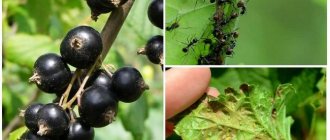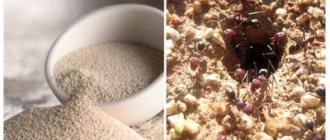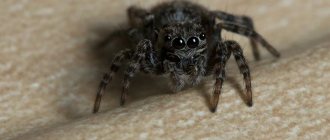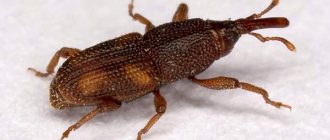How does semolina work on ants?
While relaxing at the dacha, you may encounter clusters of insects near trees and bushes with sweet berries and fruits. Ants choose cherries or gooseberries - the sweeter the fruit, the more likely an anthill will appear at its roots. Such a neighborhood, contrary to stereotypes, has a bad effect on plants.
In fact, semolina will not become poison for the insect - ants eat sweet semolina with pleasure, and most often they bring the treat to the queen. In the pest's stomach, the croup swells, causing its body to rupture and the insect to die.
On a note! If the queen dies, the entire colony will not be able to exist and will leave the summer cottage.
This cheap (compared to professional chemicals) folk method for pest control works flawlessly and contributes to the complete destruction of the colony.
The damage caused by ants
The benefits of hardworking insects are considerable, but the harm from ants in the garden is also great. In the forest, workers help the trees by breeding aphids in their foliage. This is how plants fight fungus. In the garden, aphids disfigure young plants and prevent them from developing.
Hardworking arthropods protect aphids from other insects by consuming sugary products secreted by aphids, and with the onset of cold weather they carry them to the nest. In the spring, the ant family again plants pests on young leaves in order to further use it for their own purposes. But it’s not just aphids that bother gardeners.
Damage from ants in the garden
- They feed on sweet fruits and spoil them. Garden strawberries and strawberries are most often affected.
- Ants gnaw through the petals of unopened buds to get to the nectar and eat it. Because of this, the flower dies or becomes ugly.
- An anthill located on an alpine hill is difficult to remove, and its appearance spoils the aesthetics and damages the flowers.
- Insects enter the house and spoil food supplies.
- Pests love to collect the seeds of certain plants, which are considered weeds in a summer cottage. As soon as a celandine bush appears near an anthill, the next year the weed will begin to grow in all the beds. This happens because its seeds are carried by ants.
- In addition to aphids, insects breed mealybugs, cicadas and some caterpillars. They all feed on plant foods and can harm plants in the garden.
Garden ants, the harm and benefits of which are obvious, are frequent visitors to garden plots. And although they fertilize the soil, gardeners prefer to get rid of insects on fruit trees and beds, using various poisons and home remedies. But sometimes it is worth fighting the aphid, and not its “owner”.
The garden ant is black in color and has a medium body size. It settles in colonies in the soil - both in greenhouses and in open ground. He “breeds” and protects aphids. In addition, ants can be the culprit for the lack of seedlings (they are able to gnaw the seedlings of cucumber seeds underground) or the appearance of eaten fruits.
Rules of application
Ants need to be destroyed in the spring or early summer, when they just wake up from hibernation and begin to be active. It is necessary to find a breeding ground for ants and generously sprinkle semolina around it - this way the insects will not be able to bypass the “bait”.
Note! The area can only be processed in dry and windless weather. Otherwise, the grains may be blown away from the garden or get wet due to rain.
The so-called “ant passages” should be treated with cereal - they are easy to notice by looking around the space near the insects’ home. These are deep paths along which pests move during the day.
We will have to “neutralize” other favorite places of pests - sweet plantings in the garden and greenhouses.
To effectively get rid of ants using semolina, after processing it will have to be covered with earth and branches to hide it from birds. At the same time, the treat will remain accessible to insects.
Within a few days, the decrease in the population will become noticeable; the final elimination of the pest will occur in 1–1.5 weeks.
Why are ants difficult to get rid of?
Since getting rid of house ants in an apartment is quite difficult, let’s look at why difficulties arise during this process:
- Ants are incredibly tenacious; some individuals have adapted to survive even after being treated with poison.
- Even if you managed to defeat several dozen ants, the problem is not solved, since they multiply quite quickly.
- If their anthill was discovered by a person, they immediately look for a new place of residence, within your apartment.
- The ants that we see in our home are only a few percent of the total number. These ants get food, the rest are very well camouflaged in hard-to-reach places.
We recommend reading: How to get rid of salt deposits in a washing machine
Additional Ingredients
If there are too many insects in the area, one decoy against ants in the garden may not cope with the removal. In this case, specific additives will come to the rescue, which will increase the ants’ attention and interest in the poison.
Sugar
Ants love sweet foods, so semolina can be mixed with sugar in a ratio of 1:3 or 1:5, depending on the number of pests. Treat the same areas with this composition (anthill, sweet garden crops and ant paths).
In this case, the likelihood that the delicacy will be eaten by the queen will increase several times.
On a note! Powdered sugar has a more effective property than sugar - due to its crushed structure, it is quickly swallowed by insects along with semolina.
Honey and jam
Sticky sweet additives such as jam and honey also have similar properties to sugar. They remove ants well, but are not so convenient and practical. In addition, the cost of such products is much higher than the price tag of 100 g of powdered sugar.
Honey or jam should be mixed into semolina carefully and in small quantities, in an approximate ratio of 1:10, to prevent the grains from sticking together into large lumps, which will be difficult for ants to chew.
A mixture of soda and semolina
An excellent alternative would be a mixture of soda and semolina, which, in addition to its direct effect, will help attract insects to a more effective remedy - sodium bicarbonate, or baking soda.
It produces an oxidizing effect on the internal organs of ants, as a result of which they disintegrate and the insect dies.
Mix soda and semolina in equal quantities; you can also add a spoonful of powdered sugar to the product - it will help to quickly attract the attention of the pest to the poison. This method can also be used in an apartment - treat areas where dead pests accumulate with the resulting preparation, and after a few days carry out wet cleaning.
Insects in the garden
Ants cause great harm to gardens and vegetable gardens. Their nests are deep underground, and if insects decide to settle under a tree, then in 2-3 years the tree will probably die. If they built their “house” in the garden, then no plants will grow next to it. In the process of arranging nests, ants can gnaw the roots of plants. In addition, insects feed on seeds and love fruit juice, so they spoil not only the plants themselves, but also the fruits. The prolonged presence of ants in the garden can lead to a change in the acidity of the soil, making it more acidic. And this negatively affects the development of various crops and jeopardizes the harvest.
Garden pests
But this is not all the troubles that await the gardener. Ants do not come to the garden alone. Along with them, aphids appear on plants and in the soil; ants use their sweet secretions as food. They protect aphids from other insects and small birds that feed on them, so their numbers rapidly increase, infecting more and more plants. Therefore, it is imperative to get rid of ants in the garden. At the same time, it is necessary to fight aphids. Its disappearance will greatly simplify the fight against ants, because they will be deprived of the “food supply” they need. And it is advisable to do this with non-chemical preparations so as not to harm beneficial insects and plants.
Alternative methods
Mixtures with semolina are not the only way to poison harmful insects. There are several other folk remedies that cope with this task no worse than semolina.
Mixture of sugar and yeast
Yeast cannot directly affect the body of ants, so you should not expect a magical result from this method. Nevertheless, it is quite effective.
A solution of sugar and yeast is mixed in a one to one ratio with the addition of a small amount of water. From the resulting mass, small balls are formed, which are laid out on “ant paths”.
Harmful insects really love the smell of yeast, so they will gladly drag the treat into the anthill. In pantries, the product will ferment, which will ruin the quality of all stored products. As a result, the insects will starve to death.
This method can also be used in apartments.
Hot peppers
You can control the pest using ground red pepper. The powder scatters near the anthill and along the notorious “ant paths.” When ingested by an insect, it burns the internal organs, causing the insect to die.
Cinnamon
Another budget product that insects are afraid of is ground packaged cinnamon. In order to get rid of annoying pests on the site, you need to dilute a sachet of the product with one or two liters of water with sugar and pour the resulting solution onto the anthill.
As in the case of yeast, fermentation processes are activated, as a result of which the ants will be forced to leave the summer cottage.
If insects attack in your apartment, simply sprinkle the areas where they are most concentrated with dry cinnamon powder. It smells aromatic, which will attract pests, and has a similar effect on the body as red pepper.
Mustard powder
The smell of mustard powder repels ants. It can be used either dry or as a solution (100 g per 10 liters of water, spray all plants in the garden once every two weeks).
3 effective ways to use mustard against ants
A mixture of powder and coffee works well. This product is also not loved by harmful ants. Mix the ingredients in a 1:1 ratio and treat the anthill itself and the “ant paths”.
Millet
Millet groats are an analogue of semolina. There is no main version why these insects do not like semolina. Most gardeners agree that when it enters the ant’s body, the cereal swells and tears the insect’s body. In addition, if millet gets into storage, at the first rain it will cause clogging of the tunnels and passages of the nasty pest due to its increase in size.
For maximum effectiveness, before use, 500 g of cereal should be soaked in lukewarm water for 10–15 minutes, then add 100 g of powdered sugar, honey or jam for sweetness. You can only remove ants in this way in the garden; pests accustomed to “kitchen” food are unlikely to pay attention to millet.
Boiling water
Filling an ant's home with boiling water is one of the easiest ways to combat ants. One bucket will be enough for a one-time treatment; it is better to get rid of harmful insects in this way for several days in a row, treating the anthill with buckets of boiling water.
A more effective option would be to prepare a saline solution - adding three kg of table salt to a bucket of boiling water (10 kg). Treating harmful ants at home with this preparation is many times more reliable than the method described above.
How to deal with insects on fruit trees
Ants are very fond of fruit trees because the fruits are sweet and excellent for food. To save the tree from damage to the root system, as well as the harvest, it is necessary to use simple folk remedies.
Carbolic acid
To prepare the solution you need to use:
- carbolic acid – 2 tbsp;
- black soap – 400 g;
- kerosene – 10 tbsp;
- water – 10 l.
After mixing the ingredients, spray the anthill and trunk. To completely get rid of insects, you need to perform several waterings, and to enhance the effect, coat the trunk with tar.
Lime
You must first find an anthill and perform one of the following actions:
- Loosen the nest and add tobacco dust or lime.
- Pollinate the plant and soil with tobacco dust in its pure form or with the addition of ash and lime. To do this, you need to mix the components in equal parts, approximately ¼ cup per 1 sq.m. No more than two treatments are allowed.
- Apply lime to the tree itself, about a meter from ground level.
Tobacco dust turns out to be very effective against ants, so it can be used to spray trees or bushes. To do this, add a liter of water to ½ cup and boil for 30 minutes. Water must be constantly monitored and topped up if necessary. The broth is left for a day, after which it is filtered with the addition of two liters of water and 15 grams of grated soap. This helps the solution stick better to the sheets; you can add baby soap. Spray 2-3 times every 10 days, but there should be more than two weeks before harvesting the fruits. To enhance the effect, lime is added.
For fruit trees, it is also recommended to use fumigation. The procedure is performed after flowering. To do this, you need to make a fire from small firewood, wood chips in a bucket and add tobacco dust. Leave in the garden for 30–120 minutes, using face protection. In greenhouses, 5–10 grams of product per 1 cubic meter is sufficient.
Garlic
Getting rid of guests can be done using products that the summer resident always has on hand. Garlic works great. With its help, it is enough to coat the paths to create a pungent odor that is intolerable to insects. They will try to quickly leave the main location.
A tincture is made to treat trees. Garlic can be replaced with onions. The recipe is simple:
- Grind the fruits and add water.
- The liquid should completely cover the garlic.
- Close the container tightly and leave for a week.
Garlic infusion is ready for use; it is diluted in equal proportions with water for further spraying of trees and repelling aphids and other insects.
Other products for treating fruit trees include:
- Add 10 liters of water to 300 grams of wormwood and leave to brew for several hours. After filtration, spray.
- Mix 1 tsp. soda with 30 ml of linseed oil, pour in a liter of water. Use the mixture for spraying; it is safe for humans and plants.
- Using Coca-Cola or other sweet soda, spray the trees, but first dilute them in water with a ratio of 5:1.
The described options are effective, but work must be carried out when there is no wind or rain outside.











